2002 Hyundai Atos maintenance
[x] Cancel search: maintenancePage 2 of 249
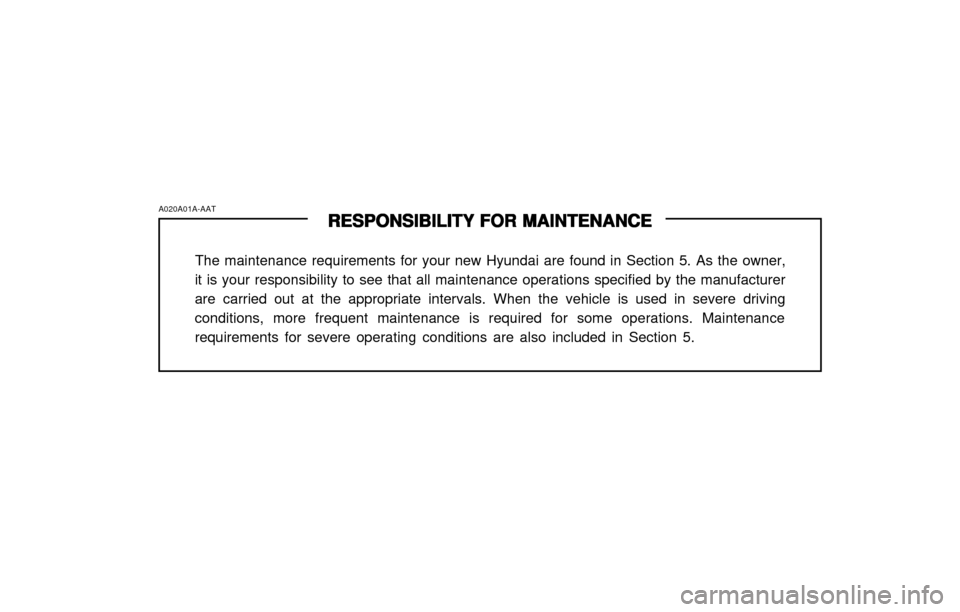
RESPONSIBILITY FOR MAINTENANCE
RESPONSIBILITY FOR MAINTENANCE RESPONSIBILITY FOR MAINTENANCE
RESPONSIBILITY FOR MAINTENANCE
RESPONSIBILITY FOR MAINTENANCE
The maintenance requirements for your new Hyundai are found in Section 5. As the owner,
it is your responsibility to see that all maintenance operations specified by the manufacturer are carried out at the appropriate intervals. When the vehicle is used in severe drivingconditions, more frequent maintenance is required for some operations. Maintenancerequirements for severe operating conditions are also included in Section 5.
A020A01A-AAT
Page 3 of 249
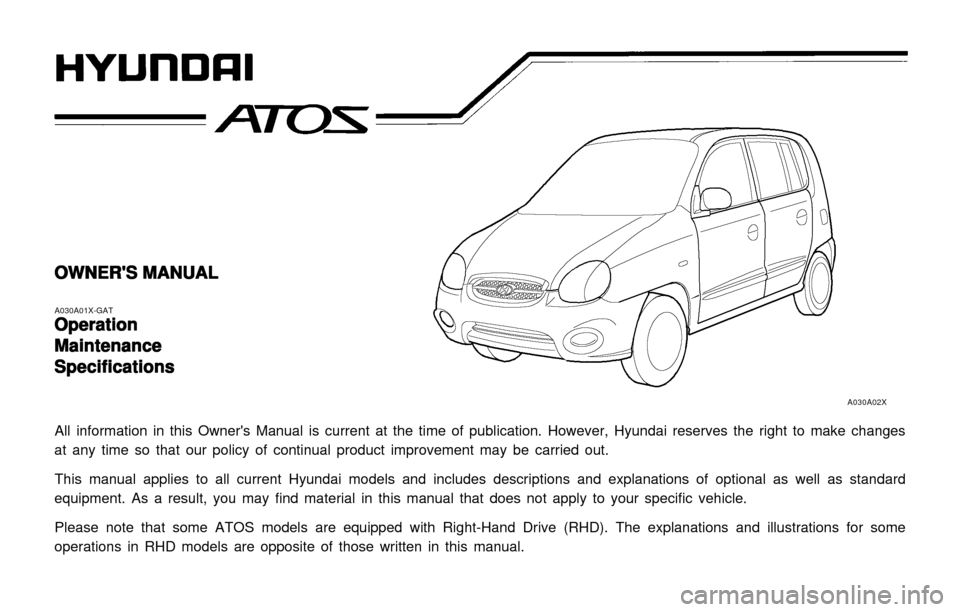
OWNER'S MANUAL
OWNER'S MANUAL OWNER'S MANUAL
OWNER'S MANUAL
OWNER'S MANUAL
A030A01X-GATOperation
Operation Operation
Operation
Operation
Maintenance
Maintenance Maintenance
Maintenance
Maintenance
Specifications
Specifications Specifications
Specifications
Specifications
All information in this Owner's Manual is current at the time of publication. However, Hyundai reserves the right to make changes
at any time so that our policy of continual product improvement may be carried out.
This manual applies to all current Hyundai models and includes descriptions and explanations of optional as well as standard
equipment. As a result, you may find material in this manual that does not apply to your specific vehicle.
Please note that some ATOS models are equipped with Right-Hand Drive (RHD). The explanations and illustrations for some
operations in RHD models are opposite of those written in this manual.
A030A02X
Page 4 of 249
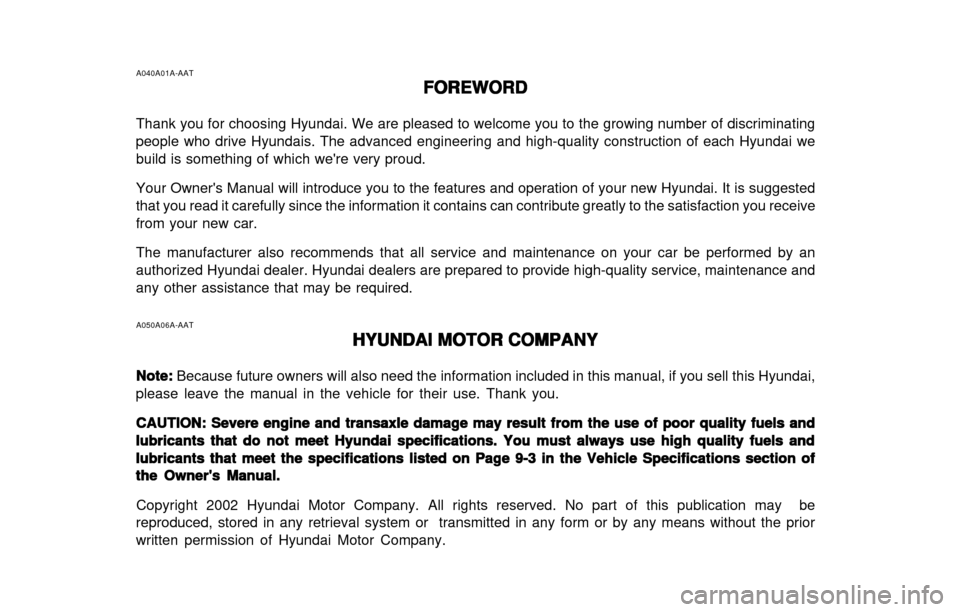
A040A01A-AATFOREWORD
FOREWORD FOREWORD
FOREWORD
FOREWORD
Thank you for choosing Hyundai. We are pleased to welcome you to the growing number of discriminating people who drive Hyundais. The advanced engineering and high-quality construction of each Hyundai we build is something of which we're very proud. Your Owner's Manual will introduce you to the features and operation of your new Hyundai. It is suggested that you read it carefully since the information it contains can contribute greatly to the satisfaction you receive from your new car. The manufacturer also recommends that all service and maintenance on your car be performed by an authorized Hyundai dealer. Hyundai dealers are prepared to provide high-quality service, maintenance and any other assistance that may be required.
A050A06A-AAT HYUNDAI MOTOR COMPANY
HYUNDAI MOTOR COMPANY HYUNDAI MOTOR COMPANY
HYUNDAI MOTOR COMPANY
HYUNDAI MOTOR COMPANY
Note:
Note: Note:
Note:
Note: Because future owners will also need the information included in this manual, if you sell this Hyundai,
please leave the manual in the vehicle for their use. Thank you.
CAUTION: Severe engine and transaxle damage may result from the use of poor quality fuels and
CAUTION: Severe engine and transaxle damage may result from the use of poor quality fuels and CAUTION: Severe engine and transaxle damage may result from the use of poor quality fuels and
CAUTION: Severe engine and transaxle damage may result from the use of poor quality fuels and
CAUTION: Severe engine and transaxle damage may result from the use of poor quality fuels and
lubricants that do not meet Hyundai specifications. You must always use high quality fuels and
lubricants that do not meet Hyundai specifications. You must always use high quality fuels and lubricants that do not meet Hyundai specifications. You must always use high quality fuels and
lubricants that do not meet Hyundai specifications. You must always use high quality fuels and
lubricants that do not meet Hyundai specifications. You must always use high quality fuels and
lubricants that meet the specifications listed on Page 9-3 in the Vehicle Specifications section of
lubricants that meet the specifications listed on Page 9-3 in the Vehicle Specifications section of lubricants that meet the specifications listed on Page 9-3 in the Vehicle Specifications section of
lubricants that meet the specifications listed on Page 9-3 in the Vehicle Specifications section of
lubricants that meet the specifications listed on Page 9-3 in the Vehicle Specifications section of
the Owner's Manual.
the Owner's Manual. the Owner's Manual.
the Owner's Manual.
the Owner's Manual.
Copyright 2002 Hyundai Motor Company. All rights reserved. No part of this publication may be
reproduced, stored in any retrieval system or transmitted in any form or by any means without the priorwritten permission of Hyundai Motor Company.
Page 8 of 249
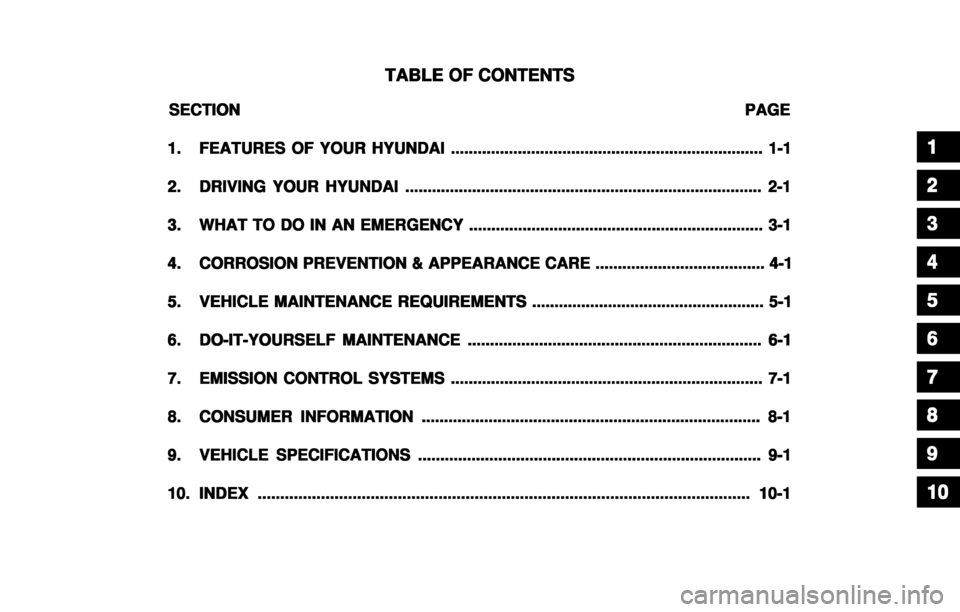
TABLE OF CONTENTS
TABLE OF CONTENTS TABLE OF CONTENTS
TABLE OF CONTENTS
TABLE OF CONTENTS
SECTION PAGE
SECTION PAGE SECTION PAGE
SECTION PAGE
SECTION PAGE
1.1.
1.1.
1. FEATURES OF YOUR HYUNDAI ...................................................................... 1-1
FEATURES OF YOUR HYUNDAI ...................................................................... 1-1 FEATURES OF YOUR HYUNDAI ...................................................................... 1-1
FEATURES OF YOUR HYUNDAI ...................................................................... 1-1
FEATURES OF YOUR HYUNDAI ...................................................................... 1-1
2.2.
2.2.
2. DRIVING YOUR HYUNDAI ................................................................................ 2-1
DRIVING YOUR HYUNDAI ................................................................................ 2-1 DRIVING YOUR HYUNDAI ................................................................................ 2-1
DRIVING YOUR HYUNDAI ................................................................................ 2-1
DRIVING YOUR HYUNDAI ................................................................................ 2-1
3.3.
3.3.
3. WHAT TO DO IN AN EMERGENCY .................................................................. 3-1
WHAT TO DO IN AN EMERGENCY .................................................................. 3-1 WHAT TO DO IN AN EMERGENCY .................................................................. 3-1
WHAT TO DO IN AN EMERGENCY .................................................................. 3-1
WHAT TO DO IN AN EMERGENCY .................................................................. 3-1
4.4.
4.4.
4. CORROSION PREVENTION & APPEARANCE CARE ...................................... 4-1
CORROSION PREVENTION & APPEARANCE CARE ...................................... 4-1 CORROSION PREVENTION & APPEARANCE CARE ...................................... 4-1
CORROSION PREVENTION & APPEARANCE CARE ...................................... 4-1
CORROSION PREVENTION & APPEARANCE CARE ...................................... 4-1
5.5.
5.5.
5. VEHICLE MAINTENANCE REQUIREMENTS .................................................... 5-1
VEHICLE MAINTENANCE REQUIREMENTS .................................................... 5-1 VEHICLE MAINTENANCE REQUIREMENTS .................................................... 5-1
VEHICLE MAINTENANCE REQUIREMENTS .................................................... 5-1
VEHICLE MAINTENANCE REQUIREMENTS .................................................... 5-1
6.6.
6.6.
6. DO-IT-YOURSELF MAINTENANCE .................................................................. 6-1
DO-IT-YOURSELF MAINTENANCE .................................................................. 6-1 DO-IT-YOURSELF MAINTENANCE .................................................................. 6-1
DO-IT-YOURSELF MAINTENANCE .................................................................. 6-1
DO-IT-YOURSELF MAINTENANCE .................................................................. 6-1
7.7.
7.7.
7. EMISSION CONTROL SYSTEMS ...................................................................... 7-1
EMISSION CONTROL SYSTEMS ...................................................................... 7-1 EMISSION CONTROL SYSTEMS ...................................................................... 7-1
EMISSION CONTROL SYSTEMS ...................................................................... 7-1
EMISSION CONTROL SYSTEMS ...................................................................... 7-1
8.8.
8.8.
8. CONSUMER INFORMATION ............................................................................ 8-1
CONSUMER INFORMATION ............................................................................ 8-1 CONSUMER INFORMATION ............................................................................ 8-1
CONSUMER INFORMATION ............................................................................ 8-1
CONSUMER INFORMATION ............................................................................ 8-1
9.9.
9.9.
9. VEHICLE SPECIFICATIONS ............................................................................. 9-1
VEHICLE SPECIFICATIONS ............................................................................. 9-1 VEHICLE SPECIFICATIONS ............................................................................. 9-1
VEHICLE SPECIFICATIONS ............................................................................. 9-1
VEHICLE SPECIFICATIONS ............................................................................. 9-1
10.10.
10.10.
10. INDEX ............................................................................................................. 10-1
INDEX ............................................................................................................. 10-1 INDEX ............................................................................................................. 10-1
INDEX ............................................................................................................. 10-1
INDEX ............................................................................................................. 10-1
11
11
1
22
22
2
33
33
3
44
44
4
55
55
5
66
66
6
77
77
7
88
88
8
99
99
9
1010
1010
10
Page 10 of 249

FEATURES OF YOUR HYUNDAI
FEATURES OF YOUR HYUNDAI FEATURES OF YOUR HYUNDAI
FEATURES OF YOUR HYUNDAI
FEATURES OF YOUR HYUNDAI
1- 1
1. FEATURES OF
YOUR HYUNDAI
B010A01A-GAT FUEL RECOMMENDATIONS Use Unleaded Gasoline Unleaded gasoline with a Pump Octane Rating of 87 (Research Octane Number 91) or highermust be used in Hyundai vehicle. If leaded gaso-line is used, it will cause the catalytic converter tobecome ineffective and the emission controlsystem to malfunction.This can also result in increased maintenanceexpense. To avoid accidental use of leaded fuel,the larger nozzle used with leaded gasoline atservice stations can not be inserted into fuel tankopening of Hyundai vehicle. NOTE:
o For some countries, Hyundai vehicles are
designed to use leaded gasoline. Whenyou are going to use leaded gasoline, askto Hyundai dealer whether leaded gaso-line in your vehicle is available or not.
o Octane Rating of leaded gasoline is same with unleaded one.
B010B01A-AAT What About Gasohol? Gasohol (a mixture of 90% unleaded gasoline and 10% ethanol or grain alcohol) may be usedin your Hyundai. However, if your engine devel-ops drive ability problems, the use of 100%unleaded gasoline is recommended. Fuels withunspecified quantities of alcohol, or alcoholsother than ethanol, should not be used. B010D01S-AAT Do not Use Methanol Fuels containing methanol (wood alcohol) should not be used in your Hyundai. This type of fuel canreduce vehicle performance and damage com-ponents of the fuel system. CAUTION: Your Hyundai's New Vehicle Limited War-ranty may not cover damage to the fuel sys-tem and performance problems that arecaused by the use of methanol or fuels con-taining methanol. B010E01A-AAT Gasolines for Cleaner AirTo help contribute to cleaner air, Hyundai recom- mends that you use gasolines treated with deter-gent additives, which help prevent deposit for-mation in the engine. These gasolines will helpthe engine run cleaner and the Emission ControlSystem performance. B010F01A-AAT Operation in Foreign Countries If you are going to drive your Hyundai in another country, be sure to:
o Observe all regulations regarding registra-
tion and insurance.
o Determine that acceptable fuel is available. B020A01X-GAT BREAKING IN YOUR NEW HYUNDAI During the First 2,000 km (1,200 Miles) No formal "break-in" procedure is required with your new Hyundai. However, you can contributeto the economical operation and durability of yourHyundai by observing the following recommen-
dations during the first 2,000 km (1,200 miles).
o Don't drive faster than 88 km/h (55 mph).
o While driving, keep your engine speed (rpm,
or revolutions per minute) between 2000 and4000 rpm.
o Use moderate acceleration. Don't start quickly or depress the accelerator pedal fully.
B010A01X
1
Page 25 of 249
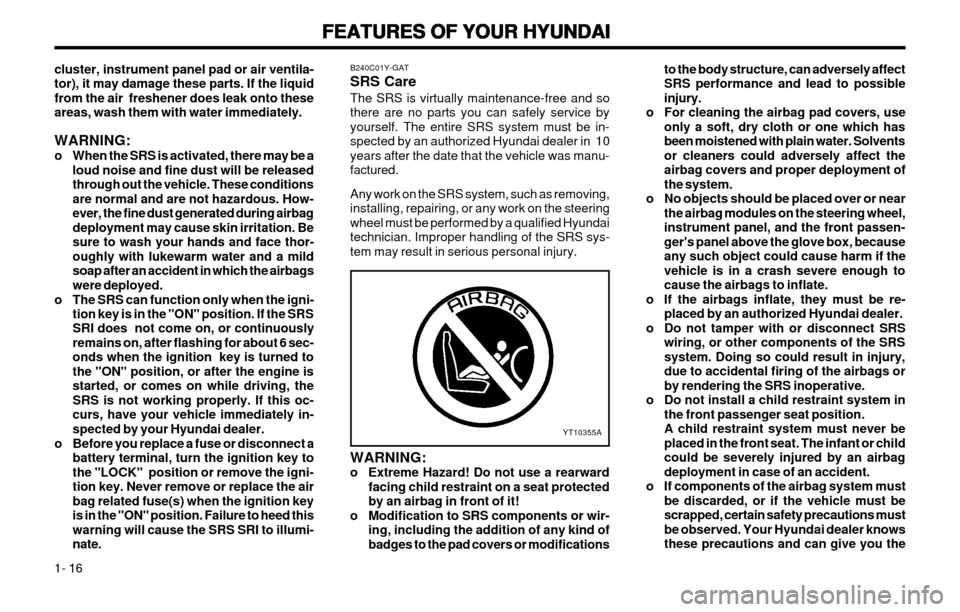
FEATURES OF YOUR HYUNDAI
FEATURES OF YOUR HYUNDAI FEATURES OF YOUR HYUNDAI
FEATURES OF YOUR HYUNDAI
FEATURES OF YOUR HYUNDAI
1- 16 to the body structure, can adversely affect SRS performance and lead to possibleinjury.
o For cleaning the airbag pad covers, use only a soft, dry cloth or one which hasbeen moistened with plain water. Solventsor cleaners could adversely affect theairbag covers and proper deployment ofthe system.
o No objects should be placed over or near the airbag modules on the steering wheel,instrument panel, and the front passen-ger's panel above the glove box, becauseany such object could cause harm if thevehicle is in a crash severe enough tocause the airbags to inflate.
o If the airbags inflate, they must be re- placed by an authorized Hyundai dealer.
o Do not tamper with or disconnect SRS wiring, or other components of the SRSsystem. Doing so could result in injury,due to accidental firing of the airbags orby rendering the SRS inoperative.
o Do not install a child restraint system in the front passenger seat position.A child restraint system must never beplaced in the front seat. The infant or childcould be severely injured by an airbagdeployment in case of an accident.
o If components of the airbag system must be discarded, or if the vehicle must bescrapped, certain safety precautions mustbe observed. Your Hyundai dealer knowsthese precautions and can give you the
YT10355A
cluster, instrument panel pad or air ventila- tor), it may damage these parts. If the liquidfrom the air freshener does leak onto theseareas, wash them with water immediately. WARNING:
o When the SRS is activated, there may be a loud noise and fine dust will be released through out the vehicle. These conditionsare normal and are not hazardous. How-ever, the fine dust generated during airbagdeployment may cause skin irritation. Besure to wash your hands and face thor-oughly with lukewarm water and a mildsoap after an accident in which the airbagswere deployed.
o The SRS can function only when the igni- tion key is in the "ON" position. If the SRSSRI does not come on, or continuouslyremains on, after flashing for about 6 sec-onds when the ignition key is turned tothe "ON" position, or after the engine isstarted, or comes on while driving, theSRS is not working properly. If this oc-curs, have your vehicle immediately in-spected by your Hyundai dealer.
o Before you replace a fuse or disconnect a battery terminal, turn the ignition key tothe "LOCK" position or remove the igni-tion key. Never remove or replace the airbag related fuse(s) when the ignition keyis in the "ON" position. Failure to heed thiswarning will cause the SRS SRI to illumi-nate. B240C01Y-GAT SRS CareThe SRS is virtually maintenance-free and so there are no parts you can safely service byyourself. The entire SRS system must be in-spected by an authorized Hyundai dealer in 10years after the date that the vehicle was manu-factured. Any work on the SRS system, such as removing, installing, repairing, or any work on the steeringwheel must be performed by a qualified Hyundaitechnician. Improper handling of the SRS sys-tem may result in serious personal injury. WARNING:
o Extreme Hazard! Do not use a rearward
facing child restraint on a seat protectedby an airbag in front of it!
o Modification to SRS components or wir- ing, including the addition of any kind ofbadges to the pad covers or modifications
Page 32 of 249

FEATURES OF YOUR HYUNDAI
FEATURES OF YOUR HYUNDAI FEATURES OF YOUR HYUNDAI
FEATURES OF YOUR HYUNDAI
FEATURES OF YOUR HYUNDAI
1- 23
B340B01A-AAT Lane Change Signal To indicate a lane change, move the lever up or down to a point where it begins flashing.The lever will automatically return to the centerposition when released.
B340A01A-AAT COMBINATION TURN SIGNAL, HEADLIGHT AND HIGH-BEAM SWITCH Turn Signal Operation Pulling down on the lever causes the turn signals on the left side of the car to blink. Pushing upwardon the lever causes the turn signals on the rightside of the car to blink. As the turn is completed,the lever will automatically return to the centerposition and turn off the turn signals at the sametime. If either turn signal indicator light blinksmore rapidly than usual, goes on but does notblink, or does not go on at all, there is a malfunc-tion in the system. Check for a burned-out fuse orbulb or see your Hyundai dealer.
B340B01X
B310A01A-GAT ODOMETERThe odometer records the total driving distance in kilometers or miles, and is useful for keeping arecord for maintenance intervals. NOTE: Any alteration of the odometer may void yourwarranty coverage. B320A01A-GAT TRIP ODOMETER The trip odometer may be used to conveniently record trip distances. Push the reset knob to setthe counter to zero. B340C01A-AAT Headlight Switch To operate the headlights, turn the barrel on the end of the multi-function switch. The first positionturns on the parking lights, sidelights, tail lightsand instrument panel lights. The second positionturns on the headlights.
B340C01X
B340F01A-GAT Daytime Running Lights (If Installed) Your Hyundai is equipped with daytime running lights. The daytime running lights are used toimprove visibility for oncoming traffic. Your vehi-cle daytime running lights are designed to remainon continuously when the engine is operatingeven though the headlight switch is in the "OFF"position. However, the daytime running lights willbe off while the parking brake is applied.
Page 72 of 249

DRIVING YOUR HYUNDAI
DRIVING YOUR HYUNDAI DRIVING YOUR HYUNDAI
DRIVING YOUR HYUNDAI
DRIVING YOUR HYUNDAI
2- 9
resulting in the engine bucking. If this hap- pens, shift to a lower gear. Over-revving isracing the engine beyond its safe limit. Thiscan be avoided by shifting at the recom-mended speeds.
o Use your air conditioning sparingly. The air conditioning system is operated by enginepower so your fuel economy is reducedwhen you use it.
C150A01A-AAT SMOOTH CORNERING
SMOOTH CORNERING SMOOTH CORNERING
SMOOTH CORNERING
SMOOTH CORNERING
Avoid braking or gear changing in corners,
especially when roads are wet. Ideally, cornersshould always be taken under gentle accelera-tion. If you follow these suggestions, tire wearwill be held to a minimum.
C160A01A-AATWINTER DRIVING
WINTER DRIVING WINTER DRIVING
WINTER DRIVING
WINTER DRIVING
The more severe weather conditions of winter
result in greater wear and other problems. Tominimize the problems of winter driving, youshould follow these suggestions:
C160B01A-GATSnowy or Icy Conditions
Snowy or Icy Conditions Snowy or Icy Conditions
Snowy or Icy Conditions
Snowy or Icy Conditions
To drive your vehicle in deep snow, it may be
necessary to use snow tires or to install tirechains on your tires. If snow tires are needed,
it is necessary to select tires equivalent in size
and type to the original equipment tires.
o Be sure that the wheels are aligned correct-
ly. Improper alignment can result from hittingcurbs or driving too fast over irregular sur-faces. Poor alignment causes faster tirewear and may also result in other problemsas well as greater fuel consumption.
o Keep your car in good condition. For better fuel economy and reduced maintenancecosts, maintain your car in accordance withthe maintenance schedule in Section 5. Ifyou drive your car in severe conditions,more frequent maintenance is required (seeSection 5 for details).
o Keep your car clean. For maximum service, your Hyundai should be kept clean and freeof corrosive materials. It is especially impor-tant that mud, dirt, ice, etc. not be allowed toaccumulate on the underside of the car. Thisextra weight can result in increased fuelconsumption and also contribute to corro-sion.
o Travel lightly. Don't carry unnecessary weight in your car. Weight reduces fuel economy.
o Don't let the engine idle longer than neces- sary. If you are waiting (and not in traffic),turn off your engine and restart only whenyou're ready to go.
o Remember, your Hyundai does not require extended warm-up. As soon as the engine isrunning smoothly, you can drive away. Invery cold weather, however, give your en-gine a slightly longer warm-up period.
o Don't "lug" or "over-rev" the engine. Lugging is driving too slowly in too high a gear
C140A01A-AAT
DRIVING FOR ECONOMY
DRIVING FOR ECONOMY DRIVING FOR ECONOMY
DRIVING FOR ECONOMY
DRIVING FOR ECONOMY
You can save fuel and get more kilometers from
your car if you follow these suggestions:
o Drive smoothly. Accelerate at a moderate rate. Don't make "jack-rabbit" starts or full- throttle shifts and maintain a steady cruisingspeed. Don't race between stoplights. Try toadjust your speed to that of the other trafficso you don't have to change speeds unnec-essarily. Avoid heavy traffic whenever pos-sible. Always maintain a safe distance fromother vehicles so you can avoid unneces-sary braking. This also reduces brake wear.
o Drive at a moderate speed. The faster you drive, the more fuel your car uses. Driving ata moderate speed, especially on the high-way, is one of the most effective ways toreduce fuel consumption.
o Don't "ride" the brake or clutch pedal. This can increase fuel consumption and alsoincrease wear on these components. In ad-dition, driving with your foot resting on thebrake pedal may cause the brakes to over-heat, which reduces their effectiveness andmay lead to more serious consequences.
o Take care of your tires. Keep them inflated to the recommended pressure. Incorrect in-flation, either too much or too little, results inunnecessary tire wear. Check the tire pres-sures at least once a month.